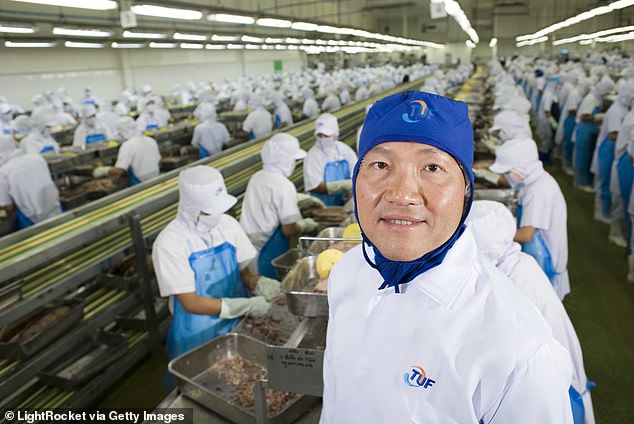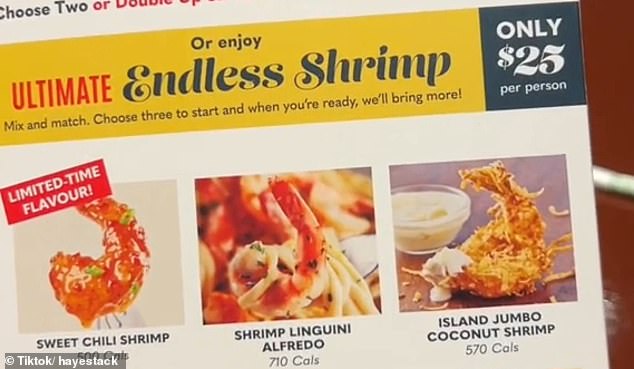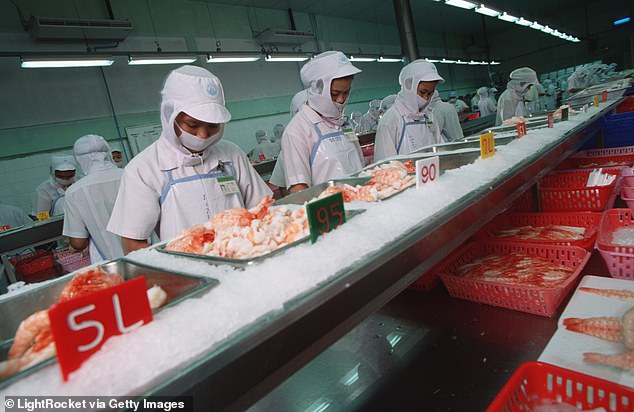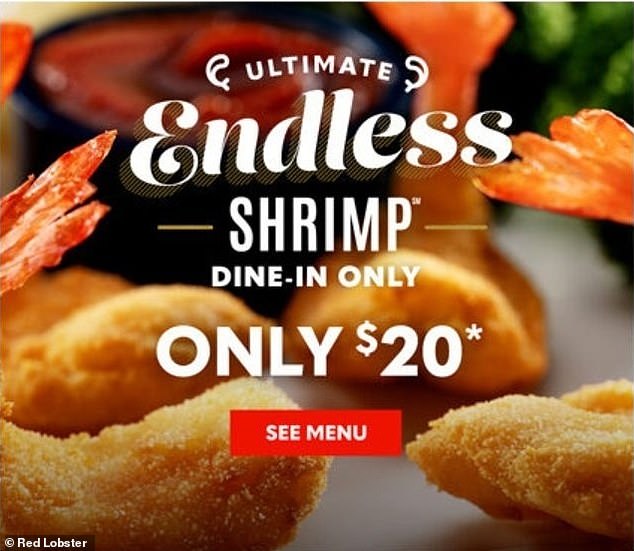Red Lobster officially files for bankruptcy after being rinsed of cash by all you can eat shrimp deals
Red Lobster has filed for Chapter 11 bankruptcy protection after closing nearly 100 restaurants across America.
The seafood chain, which has closed restaurants in 27 states, has struggled in recent years with rising rent and labor costs as well as promotions like its iconic all-you-can-eat shrimp deal that backfired.
The demand for such a recent promotion overwhelmed restaurants, Reportedly contributing to hundreds of millions in losses.
The seafood restaurant chain said in a court filing late Sunday that it has more than 100,000 creditors and estimated assets between $1 billion and $10 billion. The company’s estimated liabilities are between $1 billion and $10 billion.
The bankruptcy filing was signed by CEO Jonathan Tibus, a corporate restructuring specialist who took the top position at Red Lobster in March.
The fishing chain has been struggling with rising rental and labor costs in recent years
Restaurant liquidator TAGeX Brands announced last week that this would be the case auction of equipment from more than 50 Red Lobster locations that recently closed.
The store closures span 21 states, reducing Red Lobster’s presence in the US cities like Denver, San Antonio, Indianapolis and Sacramento, California.
Maintaining stability at the Florida chain has been problematic due to multiple ownership changes in its 56-year history.
Earlier this year, Thai Union Group, co-owner of Red Lobster, one of the world’s largest seafood suppliers, announced its intention to exit its minority investment in the dining chain.
Thai Union first invested in Red Lobster in 2016 and increased its stake in 2020.
At the time of the January announcement about its plans to divest, CEO Thiraphong Chansiri said the COVID-19 pandemic, industry headwinds and rising operating costs had hit the dining chain hard and were causing “long-term negative financial contributions to Thai Union and its shareholders’ had caused.
For the first nine months of 2023, the Thai company reported a $19 million share of Red Lobster’s losses.
Red Lobster’s roots date back to 1968, when the first restaurant was founded opened in Lakeland, Florida.
The chain has grown rapidly since then and has more than 700 locations worldwide.
However, the company was forced to file for bankruptcy after the $25 “endless shrimp” promotion.
The offering, which launched as a permanent part of the menu last June, is virtually identical to a 2003 deal – and the problems it caused are virtually identical too.
Back then it was “endless crab.” It was great for hungry seafood lovers, but a disaster for the restaurant — by the time it pulled the plug after just seven weeks, Red Lobster had lost $3.3 million.

Thiraphong Chansiri, CEO of Thai Union – the majority owner of Red Lobster – at one of the company’s factories in Thailand. He is one of the executives believed to be behind the endless supply of $20 shrimp

The chain started in 1968 as a single restaurant in Lakeland, Florida. The endless shrimp started at $20 but then went up to $25 and then $27.
“It wasn’t the second all-you-can-eat experience, it was the third” that hurt profits, a Red Lobster executive told analysts at the time in 2003.
This time the deal was also hugely popular, with some customers sticking around for hours to see how much they could eat. One girl achieved 108 in four hours.
“I set a new record at my local Red Lobster, this is my greatest achievement in life,” the poster explained in her video.
More people started taking advantage of the offer than the company expected. But instead of completing the deal, bosses kept it going for six months – and the losses dwarfed the amount lost on endless crabs 20 years earlier.
Seafood lovers devouring plates of shrimp were the main reason Thai Union, Red Lobster’s majority shareholder, lost $11 million in just three months, shortly after the deal opened.
Ludovic Garnier, chief financial officer, said: “We knew the price was cheap, but the idea was to attract more visitors to the restaurants.”
“So we wanted to increase our traffic, but it didn’t work.”
“For those who have been to the US recently, $20 was very cheap. And the reason for this promotion was that we knew the price was cheap, but the idea was to attract more visitors to the restaurants,” CFO Ludovic Garnier said in November.
“But something that was different from our expectation is that the proportion of people who selected for these promotions was much higher than expected,” he added.

Workers at the Thai Union Frozen food processing plant outside Bangkok clean and prepare freshly cooked shrimp

Endless Shrimp started at $20 but was too popular and cost millions of dollars
Simply put: it was too cheap. Hospitality experts are surprised that the chain did not realize how badly things could go wrong, especially because they repeated a mistake.
“In today’s environment, consumers are looking for value and are looking to stretch their budgets where they can,” said Jim Salera, restaurant research analyst at Stephens. LA times.
“For $20, it is entirely possible for a consumer to eat well beyond the very small profit margin.”
The price went to $25 and then $27, but losses mounted. The following quarter, the company lost $12.5 million. The total costs for Thai Union have been much higher, as the company now has to write down $500 million as it wants to sell Red Lobster.
Endless Shrimp had been available at Red Lobster for twenty years, but was only offered for a few weeks each year.
But Thai Union – run by Thiraphong Chansiri – made it a permanent fixture on the menu last June.
The Bangkok-based seafood producer’s bosses saw it as a way to sell the thousands of tons of shrimp it caught in Asia — and also to drive traffic to the Red Lobster restaurants it now owns in the U.S., where the number of customers decreased. They saw it as a win-win situation.
“If you were a big shrimp company in Thailand, it would be a good idea,” a former Red Lobster executive told me CNN.
It wasn’t profitable at the $20 price point, or even when they put it on the market.
And it has seriously affected the service. Restaurants had long wait times as customers sat at tables for hours and, of course, ate shrimp.
Chansiri said in November: “We expected a 20 percent increase in customer traffic, but the actual number was up to 40 percent.”
Other chains that offer all-you-can-eat have managed to make this work, experts say. They point to buffet chains Golden Coral and Sizzle, which offer multiple portions at a flat rate, and Olive Garden with its unlimited salads and breadsticks.
Eric Chiang, an economics professor at the University of Nevada, Las Vegas – and also a fan of buffets – told the LA Times that Red Lobster has made significant mistakes.
The price was too low and they offered something that is usually expensive and that people love: shrimp. It can also form the backbone of an entire meal.
Customers at Olive Garden do not stock salad and bread sticks.
“Most people also order the Taste of Italy,” he said of Olive Garden, “or something that gives you meat and pasta.”
‘[Red Lobster] didn’t have the right management company in place,” John Gordon, a restaurant analyst, said of the debacle.
The chain, which started as a single restaurant in Lakeland, Florida, in 1968, has approximately 650 locations in nearly every state.
The blunder is all the more surprising because the chain had made a similar mistake before, in 2003 with its ‘endless crab’ offering.
In addition to losing $3.3 million, the disaster ended in a major stock sell-off, which cost then-CEO Edna Morris her job.
This time there were major financial losses, managers left and the parent company Thai Union decided it had had enough of Red Lobster.
It had bought a 25 percent stake in Red Lobster in 2016 for $575 million. At that time it was one of the most important suppliers of the chain.
Four years later it bought an even larger share and became the majority shareholder.
It was in November, at the quarterly results, when the bosses said that the endless shrimp deal had cost eleven million dollars.
Two months later they had had enough.
The board of directors said they did not want to pump any more money into the beleaguered chain.
They have to write off $530 million of their investment because Red Lobster is drowning in debt and no buyers can be found.
During a presentation to investors in February, Chansiri said the situation had left him with a “big scar.”
“Other people stop eating beef,” he said. “I’m going to stop eating lobster.”
